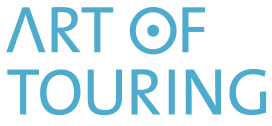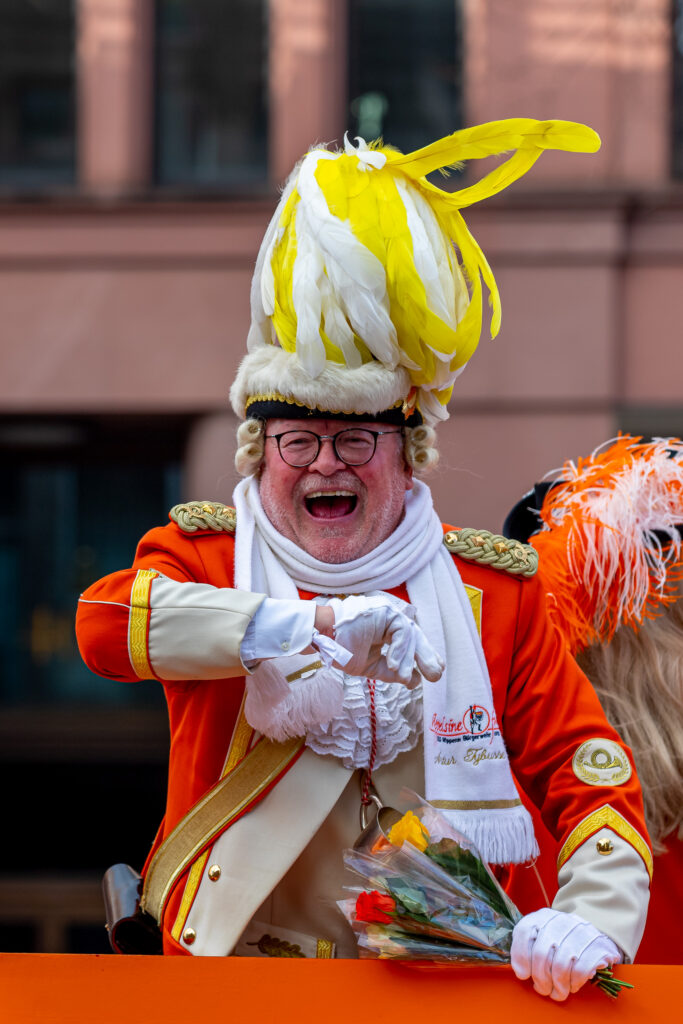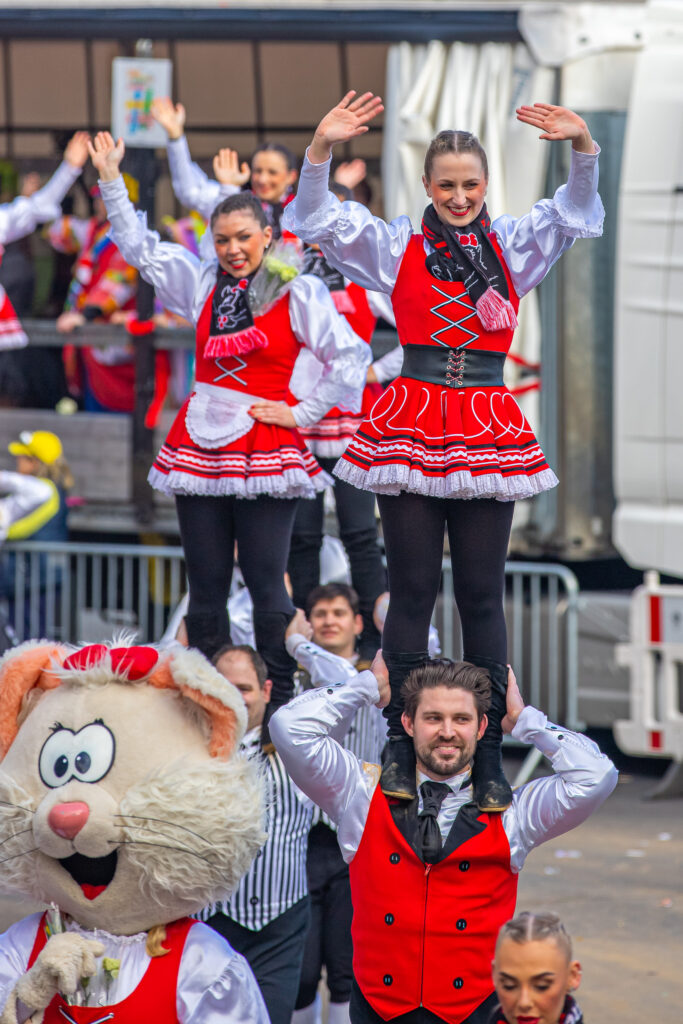For most travel destinations, February is a slow month for visitors. But not in Cologne! Why you might ask?
One word: Karneval.
The city of Cologne is the undisputed hub of Carnival celebrations in Germany. Millions of people fill the streets of Cologne every year to party, celebrate and let loose before the lenten season begins on Ash Wednesday. If you’ve never visited Cologne during Karneval, then you need to add it to your bucket list – this is truly something special!
The Karneval spirit runs deep in the blood of Kölsch people. The planning for this celebration traditionally begins at 11:11 on November 11, and runs all the way through until early February. For the last two years, Karneval celebrations have been canceled due to the pandemic. As a result, we expect the 2023 Karneval to be one of the biggest parties yet!
At Art of Touring, we are local experts on all things Cologne so we are here to share allllll of the details about Karneval with you. If you are interested in creating a custom itinerary for visiting Cologne during the celebrations, contact with us today. We can make sure you have one of the most memorable and fun experiences of your life!
This is Everything You Need to Know About Cologne Karneval
What is Cologne Karneval?
Not to be confused with a pop-up fun fair type carnival, Karneval in Germany is the equivalent to Mardi Gras in the United States or Carnival in Brazil. It is a week-long party leading up to Ash Wednesday and the start of the Lent season. There are street parades, people dressing up in costumes and masks, partying in bars and in the streets all over Cologne.
Cologne is a stronghold of the Karneval tradition. As is Rio in Brazil, Venice in Italy and New Orleans in the US, Cologne is the beating heart of Karneval celebrations in Germany. In fact, Cologne has the largest Karneval celebrations in all of Germany with over 1.5 million visitors expected at the major parade. If you want to celebrate the real thing in Germany, you have to come to Cologne!
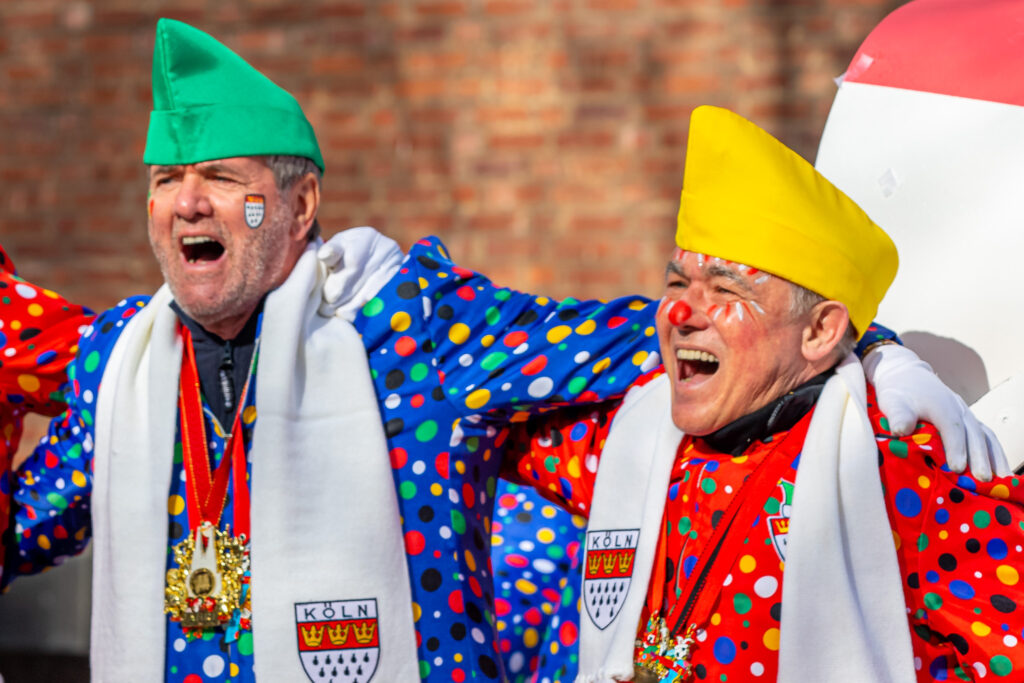
When is Cologne Karneval?
You’ll sometimes hear Karneval called the fifth season throughout the Rhineland area. In its broadest meaning, Karneval is a whole season – the “fifth season” which starts on November 11th at 11.11am every year and runs until Ash Wednesday (the start of Lent). The Christian calendar is based on the lunar cycle, so the exact dates for Karneval vary each year. Typically it happens between the middle of February to early March.
After an initial party on 11.11, things will calm down for a few weeks. The festival really starts to pick up pace in January when the Karneval societies begin holding organized events. More about those below. The climax of Karneval is a 5 day stretch from Silly Thursday (Thursday before Lent) to Violet (or Fat) Tuesday, which is the day before Ash Wednesday. Carnival is not considered a national German holiday, but in Cologne, many shops, schools, and offices will be closed from Thursday through Tuesday, with the exception of Friday, which is considered a regular workday.
History of Karneval
Dating all the way back to the Germanic tribes, Karneval has pretty deep origins. Germanic tribes typically celebrated the changing of the seasons around this time of year, transitioning from winter into spring. When Christianity rose to dominance, it absorbed existing tribal celebrations and linked it with key dates in Christian history. Karneval became a way to get out all of one’s sinful impulses before Lent.
Karneval in its current form was resurrected in 1823 with the founding of the Festival Committee. They held an inaugural parade with echoes to an ecclesiastical procession celebrating the coronation of a new emperor. However right from the start, the whole atmosphere was somewhat tongue-in-cheek. Even then, there was a healthy skepticism concerning the relationship between church and state. This feeling is alive and well today, a theme you will often see depicted in the parade floats.
Additionally, there is a ‘modern’ Karneval tradition of mocking the military. This tradition dates back to the beginning of the 19th century when Cologne was under Prussian rule. Inhabitants severely disliked this occupation, but didn’t have a safe way to express this frustration as masquerading was prohibited in 1815. As a result, local people reorganized the whole Karneval parade tradition, using it to mock Prussian rule while having a good time.
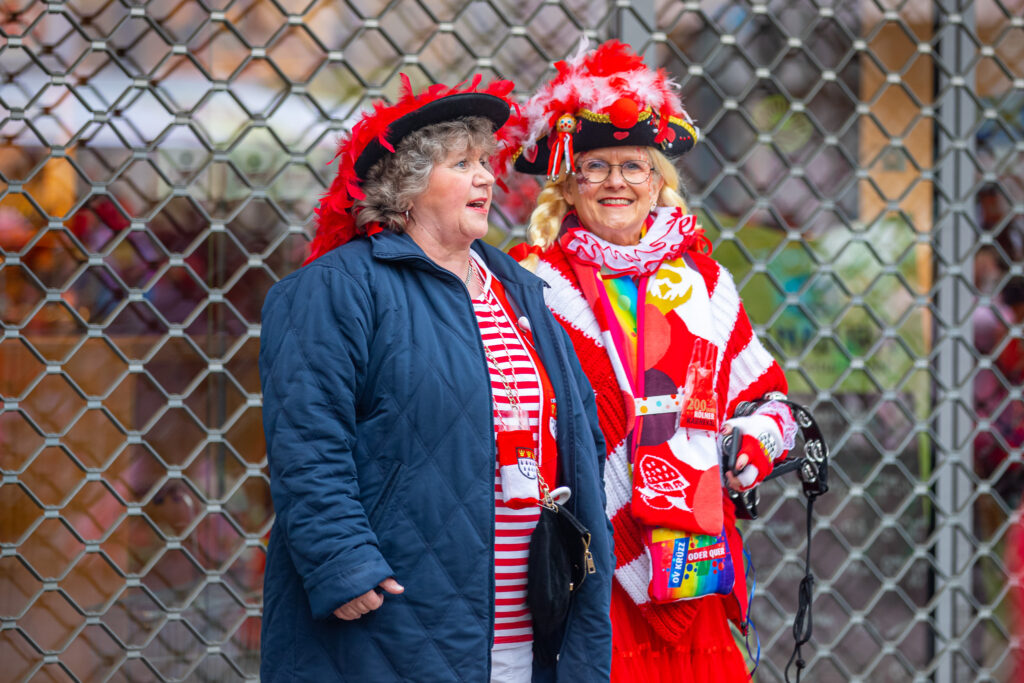
Important Traditions in Cologne Karneval
There are several key traditions that occur during Cologne Karneval, or Fastelovend as it is called in local dialect. If you boil it down, Karneval can be summarized by four German words beginning with ‘S’: singen, schunkeln, saufen, and scherzen (singing, swinging arm-in-arm, boozing, joking).
The first important tradition for Cologne Karneval is the Kölsche songs. Each year, Cologne’s local bands write and produce music that is specifically dedicated to Karneval. These songs even change year by year, so there will be new music coming out for each annual celebration. It is said that there are 10,000 songs about Cologne and Karneval. For a newbie, it can be bewildering so check out a playlist like this one to give you an idea about what the music is like.
There are some old favorite songs too, but all of the songs are sung in the local Kölsch accents. The music is typically about proclaiming one’s love for the Domstadt and the people who call it home. Revelers, whether they know each other or not, will link arms, collectively sway, and sing at the top of their lungs.
Another big tradition is cheering. During the festivities, you’ll hear people shout “Kölle Alaaf!” at seemingly every opportunity. It’ll be heard in bars, on the street, in the train. It’s everywhere because it is the unofficial “Karneval slogan”. It translates as ‘Cologne Above All Else’. The origins aren’t super clear, but it seems to go back to 1550 when it was used as toast and cheer. These days, it is a simple and easy way to declare one’s love for the Domstadt.
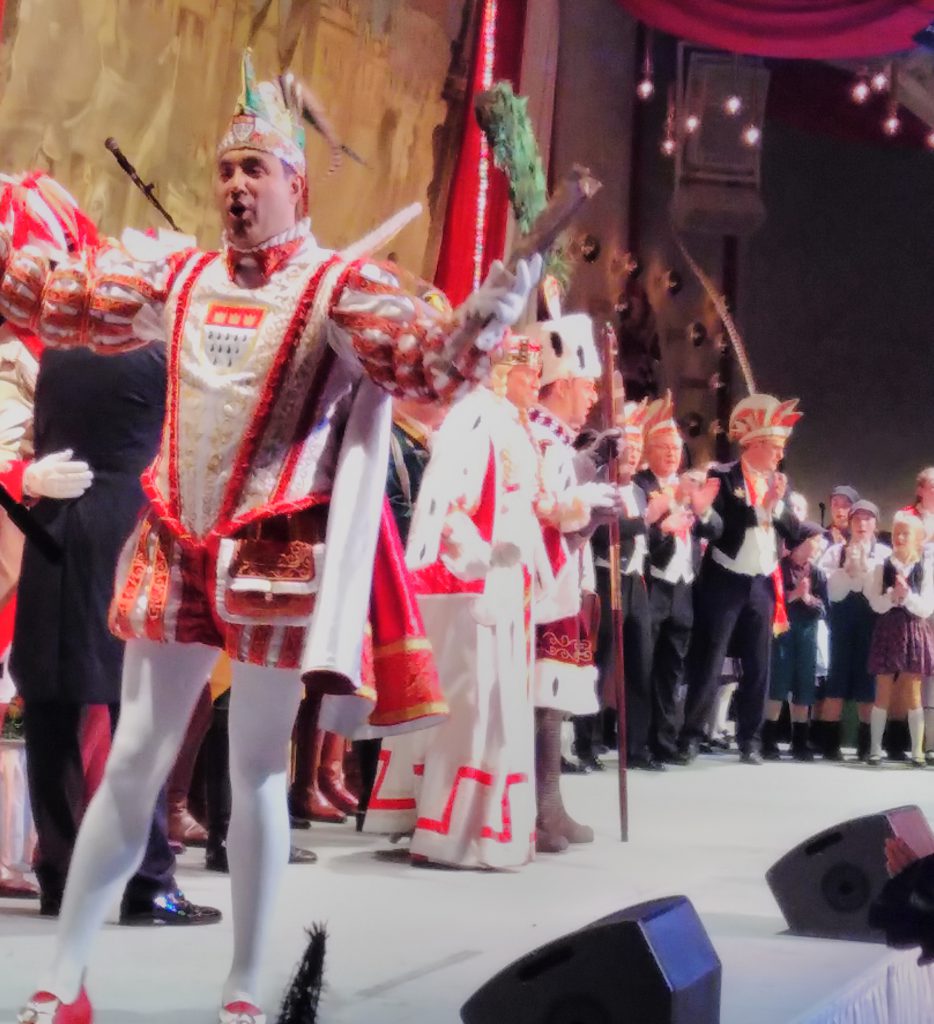
The final tradition of Cologne Karneval is the “Dreigestirn”. These are essentially the leaders of Karneval, functioning like a conductor does for a symphony orchestra. It is a trio of three characters – a prince, a peasant and a maiden – typically all of which are played by men. Wrapped in pompous red-and-white costumes, they are meant to embody the Karneval spirit. They will be in attendance at all of the big events. The Dreigestirn are selected before the Karneval season begins, and candidates are chosen from a waiting list of more than five years.
Costumes
So does everyone in Cologne wear a costume during Karneval? In essence, yes. A costume is an essential part of Karneval in Cologne. This is an event where everyone (and we mean everyone) dresses up. The costumes people wear sometimes have a meaning – such as the city’s religious past or showing off the city’s coat of arms – but many of the costumes are just for fun.
Red and white are the Cologne city colors, so you’ll see LOTS of people looking like ‘Where’s Waldo’ in striped red and white clothing. The most common costume is a jecke (or clown), but people wear just about anything during Karneval. You will notice plenty of multi-colored wigs, cowboys, tutu skirts, animal jumpsuits and pirate costumes.
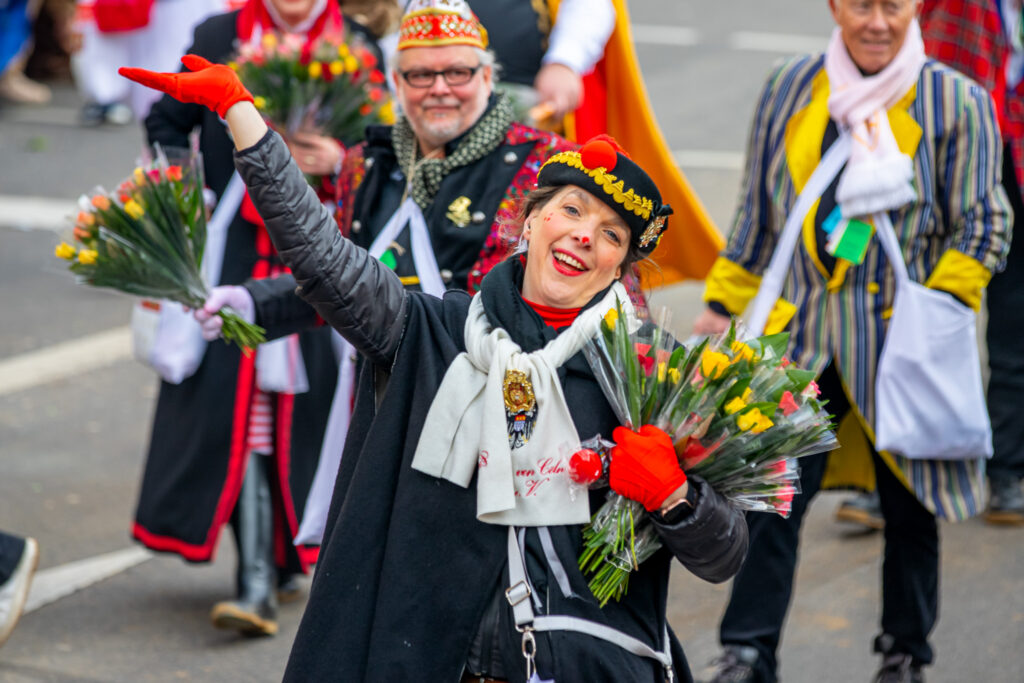
Organized Events & Karneval Societies
An interesting part of Karneval in Cologne is the Karneval Societies. These are well organized group orders, similar to fraternities or sororities, who meet regularly and represent their clubs. These clubs host their own events throughout the main Karneval season from November until the last week of Karneval. Some of the events are small affairs, while others are held in massive halls or city stadiums.
There is an extraordinary mix of traditional and alternative Karneval societies to be found. Such societies are the backbone of Karneval. They also form a fundamental element of the social structure of the city. In fact, politicians running for local office often disclose which Karneval society they are a part of, and almost all politicians need to be affiliated with one.
Below are a few of the most important Karneval Societies:
- The Große – Cologne’s oldest carnival society dating from 1823 and known as the “mother of all societies”. It puts emphasis on tradition in its costumes and music. It also celebrates its Sitzungen in the historic Gürzenich hall, dating from the 15th Century.
- StattGarde Colonia Ahoj – one of the city’s most famous Karneval societies with its roots firmly in the city’s large LGBT community. It is known for fantastic dancing, singing and musical performances.
- Kölsche Kippa Köpp – Cologne’s first post-war Jewish karneval society, arriving in 2019 onto the Karneval scene. They aim to show that Jewish people have long had a role in the celebration of Karneval. Their name is a reference to a pre-war jewish bowling club (Kleiner Kölner Kegelclub), which went on to become a Karneval society, the “Kleiner Kölner Klub”.
The societies are also typically responsible for organizing the Sitzungen or staged events during the busy last days of the celebrations. These events will be full of Karneval music, drinking, comedy and performance. One such event to highlight is the Immisitzung. This is a cabaret style event featuring performers and artists who live in Cologne but have their origins elsewhere. Its aim is to support the integration of Cologne’s diverse communities into the Karneval festivities under the motto “Jede Jeck is von woanders” (every clown comes from somewhere else).
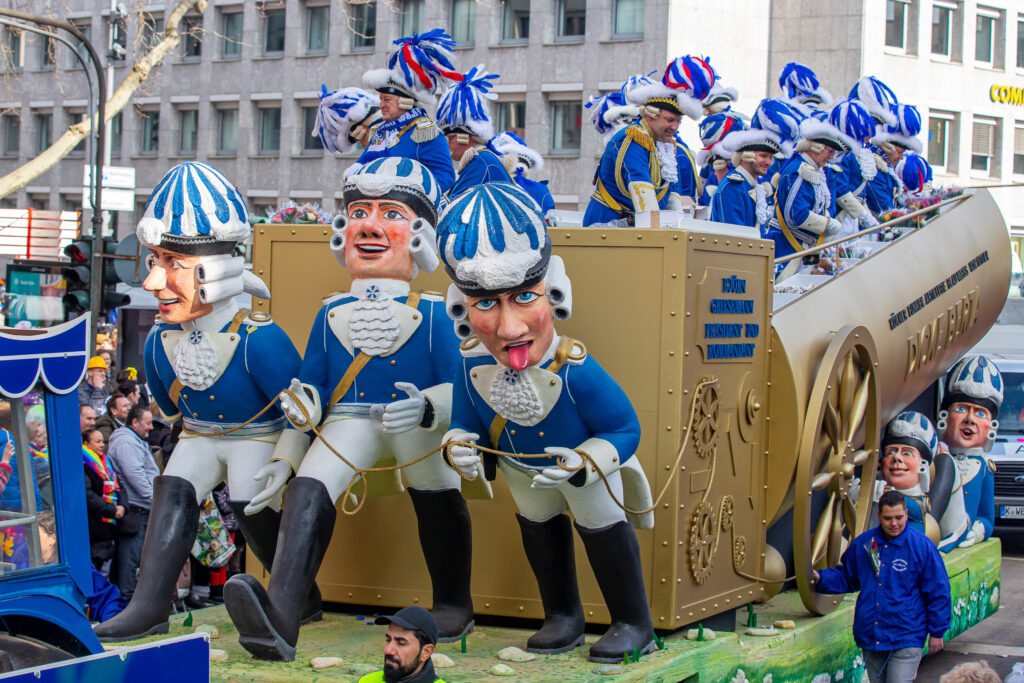
Important Days for Cologne Karneval
Kölners would say that all of Karneval is important, but there are four key days you need to know about.
Weiberfastnacht (or Silly Thursday)
This is the unofficial ‘start’ of the big Karneval celebrations. It translates to ‘feast night of the women’, and it is a day of celebration specifically reserved for the ladies. Women will gather in small groups and wander around the city cutting the necktie of any men they come across. When the men oblige, they are rewarded with a bützchen or little kiss on the cheek. Some men will line their ties with a small wire to prevent it from being cut, but it is all in good fun. Also on this day, local people will gather at Alter Markt square at 11:11 a.m. Around that time, the Dreigestirn (again, the three Karneval conductors) will emerge from city hall to join the crowds. Throughout the festivities, Kölsch beer will be flowing and cheerful dancing will ensue.
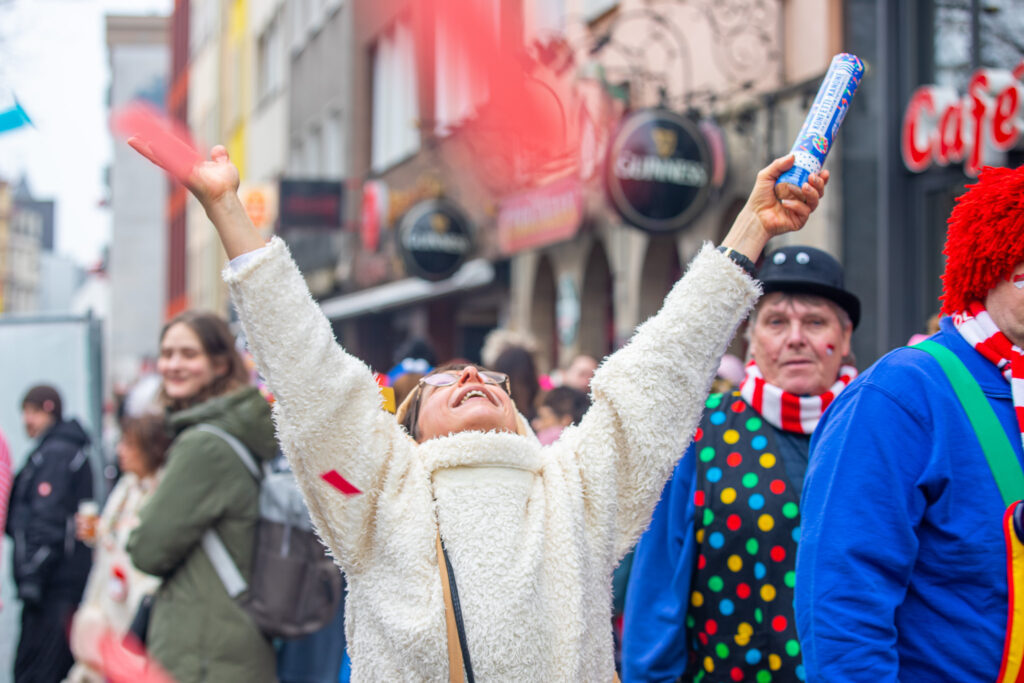
Karneval Weekend
There is no religious affiliation for the weekend of Karneval, but Saturday is the biggest day for street parties. Without the obligation of work the next day, Kölners really let loose on Saturday. Drinking starts early with a Frühschoppen, or early-morning drink. Most locals will attend a pre-game party (or three) before noon. There is also an organized morning event a Funkenbiwak in Neumarkt. With all this early inebriation, the tipsy city of Cologne is really rocking by midday. It can get pretty rowdy, and even a little scary, by night time so we recommend calling it early and sleeping off any hangover symptoms.
Another Saturday event that receives a lot of attention is the Geisterzug or ghost procession. It is the alternative Karneval parade with roots in political protests against the Iraq war in the early 1990’s. There is still a strong emphasis on political issues today. It goes through a different neighborhood of Cologne each year, so keep your eyes out for news of the procession. Find the parade to see all manner of vampires, witches and ghouls!
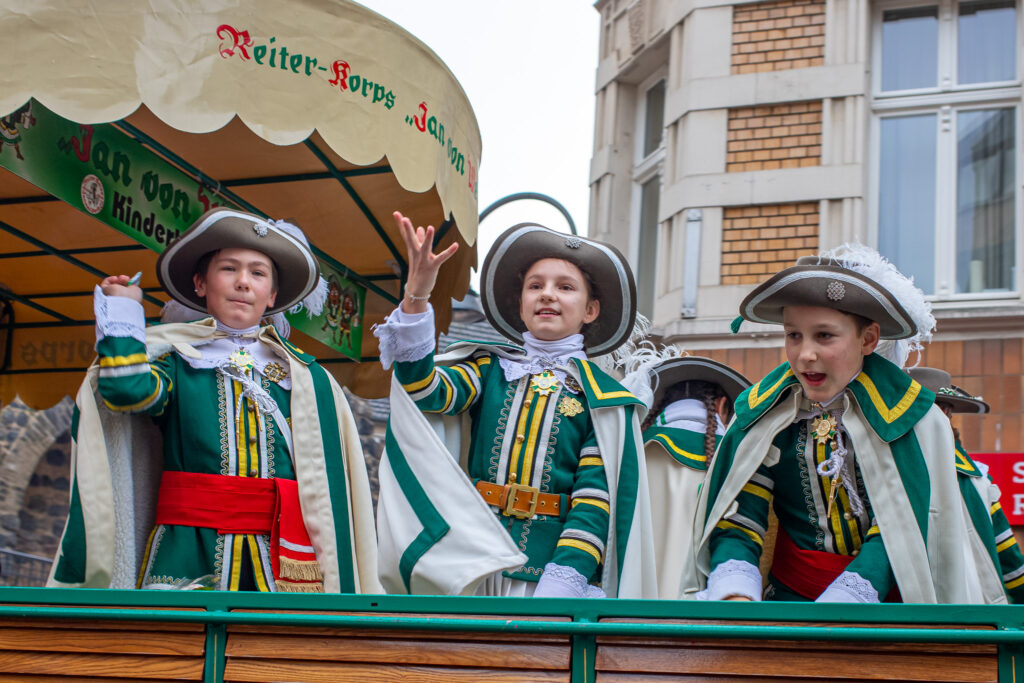
Rosenmontag (Rose Monday)
If there is one day you don’t want to miss during Karneval, it is Rosenmontag. This is the parade day, when more than 1 million people come into the city to celebrate. Once again at 11:11 am, marching bands, dancers, and floats stroll through an 8km route of Cologne’s historic old city. Over 200 floats, wagons, trailers and cars partake in the parade with approximately 13,000 people marching along. As mentioned earlier, the floats will typically use dark humor or tongue-and-cheek hints to caricature politicians or comment on current events. Throwing candy during the parade, especially kamelle (caramels), is a beloved tradition with an estimated 300 metric tons being given out each year.
Veilchendienstag (Violet Tuesday or Shrove Tuesday)
After several days of heavy partying, things start to quiet down by Shrove Tuesday. The important event today is the ceremonial Nubbelverbrennung or burning of the straw figure. Meant to serve as the symbol or scapegoat for all of the transgressions partiers may have committed during Karneval, the Nubbel is burned as a release. Throughout the city, you will see life-sized strawman strung in front of bars, restaurants and even houses. Once the sun goes down, torchlight processions are held and the Nubbels are burned. Fire rescue workers are stationed throughout the city to prevent anything from getting out of hand. The largest of these burning ceremonies takes place in Kwartier Latäng, the student district, but there are also impressive ones next to St Agnes Church and in the Altstadt.
Aschermittwoch (Ash Wednesday)
Ash Wednesday marks the official end of the “Fifth Season” and the beginning of Lent. Catholic residents will walk around with an ash cross marked on their forehead, while street cleaning machines make their way throughout Cologne cleaning up any evidence of the previous week’s festivities.
Want to experience Karneval like a local?
Art of Touring prides itself on its knowledge of our local culture, in all its dazzling shades. Our best tours are those where discussions emerge with our guests in which we can scratch the surface of the real city of Cologne and reveal its rich culture. Contact us to find out more about creating a custom Karneval themed itinerary.
